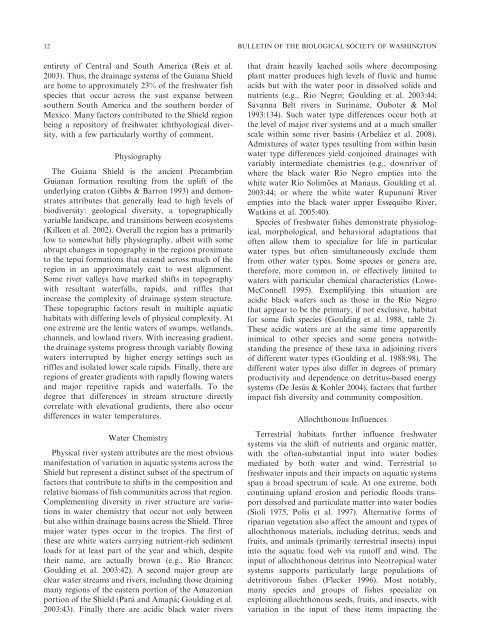Biological Society of Washington - Department of Botany ...
Biological Society of Washington - Department of Botany ...
Biological Society of Washington - Department of Botany ...
Create successful ePaper yourself
Turn your PDF publications into a flip-book with our unique Google optimized e-Paper software.
12 BULLETIN OF THE BIOLOGICAL SOCIETY OF WASHINGTON<br />
entirety <strong>of</strong> Central and South America (Reis et al.<br />
2003). Thus, the drainage systems <strong>of</strong> the Guiana Shield<br />
are home to approximately 23% <strong>of</strong> the freshwater fish<br />
species that occur across the vast expanse between<br />
southern South America and the southern border <strong>of</strong><br />
Mexico. Many factors contributed to the Shield region<br />
being a repository <strong>of</strong> freshwater ichthyological diversity,<br />
with a few particularly worthy <strong>of</strong> comment.<br />
Physiography<br />
The Guiana Shield is the ancient Precambrian<br />
Guianan formation resulting from the uplift <strong>of</strong> the<br />
underlying craton (Gibbs & Barron 1993) and demonstrates<br />
attributes that generally lead to high levels <strong>of</strong><br />
biodiversity: geological diversity, a topographically<br />
variable landscape, and transitions between ecosystems<br />
(Killeen et al. 2002). Overall the region has a primarily<br />
low to somewhat hilly physiography, albeit with some<br />
abrupt changes in topography in the regions proximate<br />
to the tepui formations that extend across much <strong>of</strong> the<br />
region in an approximately east to west alignment.<br />
Some river valleys have marked shifts in topography<br />
with resultant waterfalls, rapids, and riffles that<br />
increase the complexity <strong>of</strong> drainage system structure.<br />
These topographic factors result in multiple aquatic<br />
habitats with differing levels <strong>of</strong> physical complexity. At<br />
one extreme are the lentic waters <strong>of</strong> swamps, wetlands,<br />
channels, and lowland rivers. With increasing gradient,<br />
the drainage systems progress through variably flowing<br />
waters interrupted by higher energy settings such as<br />
riffles and isolated lower scale rapids. Finally, there are<br />
regions <strong>of</strong> greater gradients with rapidly flowing waters<br />
and major repetitive rapids and waterfalls. To the<br />
degree that differences in stream structure directly<br />
correlate with elevational gradients, there also occur<br />
differences in water temperatures.<br />
Water Chemistry<br />
Physical river system attributes are the most obvious<br />
manifestation <strong>of</strong> variation in aquatic systems across the<br />
Shield but represent a distinct subset <strong>of</strong> the spectrum <strong>of</strong><br />
factors that contribute to shifts in the composition and<br />
relative biomass <strong>of</strong> fish communities across that region.<br />
Complementing diversity in river structure are variations<br />
in water chemistry that occur not only between<br />
but also within drainage basins across the Shield. Three<br />
major water types occur in the tropics. The first <strong>of</strong><br />
these are white waters carrying nutrient-rich sediment<br />
loads for at least part <strong>of</strong> the year and which, despite<br />
their name, are actually brown (e.g., Rio Branco;<br />
Goulding et al. 2003:42). A second major group are<br />
clear water streams and rivers, including those draining<br />
many regions <strong>of</strong> the eastern portion <strong>of</strong> the Amazonian<br />
portion <strong>of</strong> the Shield (Pará and Amapá; Goulding et al.<br />
2003:43). Finally there are acidic black water rivers<br />
that drain heavily leached soils where decomposing<br />
plant matter produces high levels <strong>of</strong> fluvic and humic<br />
acids but with the water poor in dissolved solids and<br />
nutrients (e.g., Rio Negro; Goulding et al. 2003:44;<br />
Savanna Belt rivers in Suriname, Ouboter & Mol<br />
1993:134). Such water type differences occur both at<br />
the level <strong>of</strong> major river systems and at a much smaller<br />
scale within some river basins (Arbeláez et al. 2008).<br />
Admixtures <strong>of</strong> water types resulting from within basin<br />
water type differences yield conjoined drainages with<br />
variably intermediate chemistries (e.g., downriver <strong>of</strong><br />
where the black water Rio Negro empties into the<br />
white water Rio Solimões at Manaus, Goulding et al.<br />
2003:44; or where the white water Rupununi River<br />
empties into the black water upper Essequibo River,<br />
Watkins et al. 2005:40).<br />
Species <strong>of</strong> freshwater fishes demonstrate physiological,<br />
morphological, and behavioral adaptations that<br />
<strong>of</strong>ten allow them to specialize for life in particular<br />
water types but <strong>of</strong>ten simultaneously exclude them<br />
from other water types. Some species or genera are,<br />
therefore, more common in, or effectively limited to<br />
waters with particular chemical characteristics (Lowe-<br />
McConnell 1995). Exemplifying this situation are<br />
acidic black waters such as those in the Rio Negro<br />
that appear to be the primary, if not exclusive, habitat<br />
for some fish species (Goulding et al. 1988, table 2).<br />
These acidic waters are at the same time apparently<br />
inimical to other species and some genera notwithstanding<br />
the presence <strong>of</strong> these taxa in adjoining rivers<br />
<strong>of</strong> different water types (Goulding et al. 1988:98). The<br />
different water types also differ in degrees <strong>of</strong> primary<br />
productivity and dependence on detritus-based energy<br />
systems (De Jesús & Kohler 2004), factors that further<br />
impact fish diversity and community composition.<br />
Allochthonous Influences<br />
Terrestrial habitats further influence freshwater<br />
systems via the shift <strong>of</strong> nutrients and organic matter,<br />
with the <strong>of</strong>ten-substantial input into water bodies<br />
mediated by both water and wind. Terrestrial to<br />
freshwater inputs and their impacts on aquatic systems<br />
span a broad spectrum <strong>of</strong> scale. At one extreme, both<br />
continuing upland erosion and periodic floods transport<br />
dissolved and particulate matter into water bodies<br />
(Sioli 1975, Polis et al. 1997). Alternative forms <strong>of</strong><br />
riparian vegetation also affect the amount and types <strong>of</strong><br />
allochthonous materials, including detritus, seeds and<br />
fruits, and animals (primarily terrestrial insects) input<br />
into the aquatic food web via run<strong>of</strong>f and wind. The<br />
input <strong>of</strong> allochthonous detritus into Neotropical water<br />
systems supports particularly large populations <strong>of</strong><br />
detritivorous fishes (Flecker 1996). Most notably,<br />
many species and groups <strong>of</strong> fishes specialize on<br />
exploiting allochthonous seeds, fruits, and insects, with<br />
variation in the input <strong>of</strong> these items impacting the
















